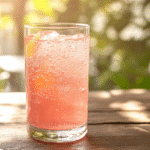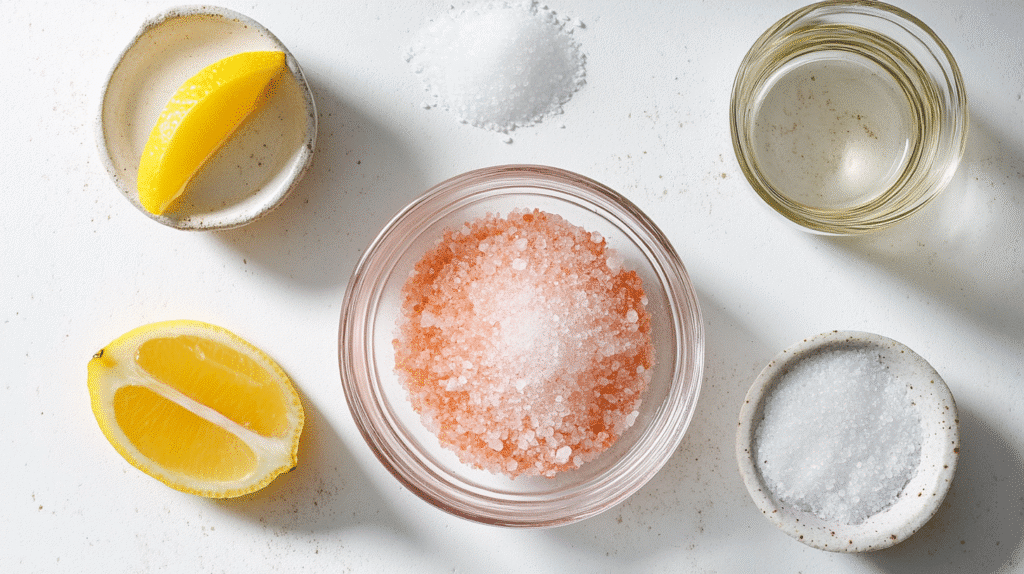You’ve probably seen the buzz about the Japanese pink salt recipe—the so-called “4-ingredient pink salt trick” lighting up TikTok and health circles.
But does it actually work? And is it really Japanese in origin, or just a catchy name for something with smart pantry swaps?
In this article, we’re digging deep (but not too seriously) into what the Japanese pink salt recipe is, why it’s trending, and how to make it at home with just a handful of budget-friendly ingredients.
If you’re into simple recipes with surprising benefits, this might be the viral trick worth trying. Let’s get into it.
Table of Contents for Japanese Pink Salt Recipe

Japanese Pink Salt Recipe
- Total Time: 2 minutes
- Yield: 1 glass 1x
Description
A refreshing 4-ingredient drink made with pink Himalayan salt, baking soda, lemon juice, and water to support hydration and daily wellness.
Ingredients
1/4 tsp pink Himalayan salt
1/4 tsp baking soda
1–2 tsp lemon juice or apple cider vinegar
8–10 oz filtered water
Instructions
Combine pink salt and baking soda in a glass.
Add lemon juice or vinegar—allow it to fizz.
Pour in filtered water.
Stir well and drink slowly.
Notes
Drink in the morning on an empty stomach or mid-day for hydration.
Not recommended for those on low-sodium diets.
- Prep Time: 2 minutes
- Cook Time: 0 minutos
- Category: Drinks
- Method: Mixing
- Cuisine: Japanese-inspired
Nutrition
- Serving Size: 1 glass
- Calories: 2
- Sugar: 0 g
- Sodium: 400mg
- Fat: 0g
- Saturated Fat: 0g
- Unsaturated Fat: 0g
- Trans Fat: 0g
- Carbohydrates: 1g
- Fiber: 0g
- Protein: 0g
- Cholesterol: 0mg
Why This Japanese Pink Salt Recipe Is Going Viral
From My Fridge to Yours: How I Got Hooked on This “Trick”
I first stumbled on the Japanese pink salt recipe while doing what I do best—scouring the fridge for something half-useful to turn into dinner.
That’s when I noticed a trend popping up in wellness groups and even food prep circles: a salty little tonic made with just four ingredients, promising everything from better hydration to curbed cravings.
Now, I grew up making do with what we had. Pink Himalayan salt wasn’t exactly a staple in our house, but table salt sure was.
These days, I keep a small jar of pink salt on hand thanks to my sister who swears it “feels fancier.”
Turns out, this so-called Japanese pink salt trick is less about rare ingredients and more about how cleverly they’re used.
What Exactly Is the Japanese Pink Salt Recipe?
At its core, the Japanese pink salt recipe combines four everyday ingredients:
- Pink Himalayan salt
- Baking soda
- Lemon juice (or apple cider vinegar)
- Filtered water
The idea? You’re making a light alkaline drink designed to support hydration and balance. Think of it like an easy version of an electrolyte drink—without the added sugar.
The name “Japanese” likely comes from the minimalism and clean ingredients, not the origin. But it’s caught on, and it definitely fits that “less-is-more” kitchen vibe.
How to Make the Japanese Pink Salt Recipe at Home
The Simple 4-Ingredient Formula You Need
The beauty of the Japanese pink salt recipe is its simplicity. You only need four ingredients, and chances are you already have most of them. Here’s what goes into a single serving:

- 1/4 tsp pink Himalayan salt (fine ground is best)
- 1/4 tsp baking soda (aluminum-free if possible)
- 1–2 tsp lemon juice or apple cider vinegar
- 8–10 oz filtered water
Combine the pink salt and baking soda in a glass. Add the lemon juice or vinegar next—it’ll fizz slightly, which is totally normal. Then pour in your water and give it a stir. That’s it. It’s ready to sip.
This drink is meant to be consumed slowly in the morning on an empty stomach, or between meals.
Some people use it before intermittent fasting to help manage energy and curb cravings. Just one tip: don’t go overboard with the salt. A little goes a long way.
Customizing Your Version: Flavors & Uses
Want to adjust the flavor? Try adding:
- A dash of fresh ginger juice for a warming kick
- A slice of cucumber for a refreshing twist
- A drop of raw honey (if not strictly fasting)
This recipe isn’t just for health trends—it also fits into certain traditional eating styles. Some folks mix a version of this into broths or sipped like a pre-meal tonic, similar to practices in Japan that pair meals with simple, mineral-rich beverages.
There are also variations like the Japanese pink salt recipe for weight loss that go deeper into timing and meal pairing, but the core idea remains the same: balance.
Next up: Does this pink salt trick actually do anything? Let’s talk benefits, real talk, and what science has to say.
Does the Japanese Pink Salt Trick Actually Work?
The Claims Behind the Craze
So, does this Japanese pink salt recipe work? That depends on what you’re hoping for. A lot of the buzz online credits it with:
- Better hydration
- More energy during fasting
- Reduced bloating
- Appetite control
- Electrolyte balance
From a practical standpoint, it makes sense. Pink Himalayan salt contains trace minerals like potassium and magnesium. Baking soda helps create an alkaline effect that some believe supports digestion.
And lemon juice or ACV adds a bit of acidity that may help with absorption.
While no one’s saying this is magic in a glass, some people do find it helpful—especially if they’re switching to a lower-carb or intermittent fasting lifestyle.
It’s a small change, but it can feel surprisingly satisfying.
One reader even shared that pairing it with our pink salt and baking soda recipe helped them skip that second coffee. Now that’s saying something.
What the Research Actually Says
There’s no official study labeled “Japanese pink salt trick,” but the ingredients have some backing on their own.
For example:
- Himalayan salt contains 80+ trace minerals, though in very small amounts
- Baking soda has been used for heartburn and digestion support
- Lemon juice and ACV may help with satiety, especially when taken before meals
None of this replaces medical advice or a balanced diet, of course. And while some swear it helps with weight management, others may not notice a huge difference. What it won’t do: act as a “fat burner” or detox you overnight.
If you’re looking for a deeper guide to how this fits into wellness goals, this pink salt variation for weight control is worth a peek.
Next up: let’s cover who should and shouldn’t use this recipe—plus some real-world tips from my own kitchen.
Who Should Use (or Skip) the Japanese Pink Salt Recipe
Is This for Everyone? Not Quite.
While the Japanese pink salt recipe is made with simple, natural ingredients, it’s not for everyone. Here’s who should be cautious:
- People with high blood pressure: Pink salt is still salt. If your doctor has told you to limit sodium, this recipe might not be for you.
- Anyone on a sodium-restricted or kidney-focused diet: Talk to your provider before trying it.
- Pregnant or nursing moms: Always best to check in with your care team first.
For most healthy adults, though, a glass a day isn’t likely to cause issues—especially if you’re using the right amounts.
The salt content is quite low, especially compared to pre-made electrolyte drinks.
If you’re unsure, you could start with the simpler version of the recipe and work your way up. Or use it only on active days when you’re sweating more.
My Honest Thoughts After a Week of Sipping
After trying the Japanese pink salt recipe for a full week, I noticed something unexpected:
I stopped craving my mid-morning snack. That’s saying a lot, because I’m usually reaching for something salty around 10 a.m.
Was it life-changing? No.
But did it help me stay hydrated, cut down on mindless munching, and feel a bit more grounded in my routine? Absolutely.
It’s a small daily ritual that fits right into my style—quick, practical, and pantry-friendly.
You can always explore other pantry upgrades too, like the versions with lemon and baking soda, or add it into your morning prep rotation for a light, refreshing start.
Conclusion
The Japanese pink salt recipe might be trending, but there’s a reason it’s sticking around—it’s easy, low-cost, and fits right into a practical wellness routine.
With just four basic ingredients, it offers a simple way to stay hydrated, manage cravings, and feel more balanced without relying on processed drinks or complicated supplements.
For me, it’s not about chasing some quick-fix detox. It’s about starting the day with something that feels intentional, especially when time (and groceries) are low.
Whether you’re experimenting with intermittent fasting, cutting back on sugar, or just curious about the hype, this little pink salt trick is worth a try.
Just be smart about it—especially if you have medical conditions—and know that even small shifts like this can help you feel more in control of your routine.
Add it to your morning, tweak it to your taste, and make it your own.
For more recipes follow me in Pinterest.
Frequently Asked Questions
What is the 4-ingredient pink salt trick?
It’s a simple DIY drink made from pink Himalayan salt, baking soda, lemon juice (or apple cider vinegar), and filtered water.
People use it to support hydration, digestion, and appetite control—especially during intermittent fasting.
What is the Japanese pink salt trick?
Though not directly rooted in Japanese cuisine, the term refers to a minimalist 4-ingredient electrolyte drink using natural, pantry-friendly ingredients.
It’s popular for its clean approach to wellness, echoing Japanese simplicity and balance.
Does the pink salt recipe work?
Anecdotally, yes—for hydration, energy, and even reduced cravings. Scientifically, the ingredients have benefits on their own, but results vary person to person.
It’s not a miracle, but it can be a helpful daily habit.
Who should not use Himalayan pink salt?
People with high blood pressure, kidney conditions, or anyone on a low-sodium diet should avoid or limit pink salt.
Always consult a healthcare provider if you’re unsure.

2 thoughts on “Japanese Pink Salt Recipe: The 4-Ingredient Wellness Trick Everyone’s Talking About”